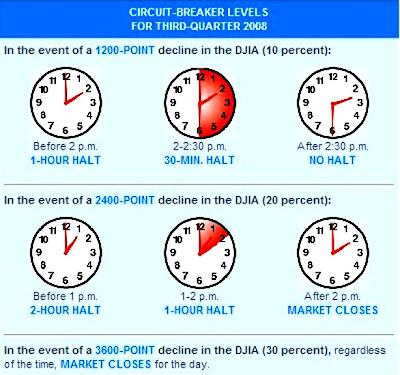Circuit Breakers and Other Market Volatility Procedures
The major stock and commodities exchanges have instituted procedures to limit mass or panic selling in times of serious market declines and volatility. These mechanisms are known as Circuit Breakers, the Collar Rule, and Price Limits. Circuit Breakers establish whether trading will be halted temporarily or stopped entirely. The Collar Rule and Price Limits affect the way trading in the securities and futures markets takes place.
Circuit Breakers
The securities and futures markets have circuit breakers that provide for brief, coordinated, cross-market trading halts during a severe market decline as measured by a single day decrease in the Dow Jones Industrial Average (DJIA).
Trading Collars
If the DJIA moves up or down two percent (2%) from the previous closing value, program trading orders to buy or sell the Standard & Poor’s 500 stocks as part of index arbitrage were restricted in response to the Crash of 1987.
On November 2, 2007, the NYSE scrapped this rule. The reason given for the rule's elimination was its ineffectiveness in curbing market volatility.
Price Limits
The futures exchanges set the price limits that aim to lessen sharp price swings in contracts, such as stock index futures. A price limit does not stop trading in the futures, but prohibits trading at prices below the pre-set limit during a price decline.
Intra-day price limits are removed at pre-set times during the trading session, such as ten minutes after the thresholds are reached or at 3:30 p.m. (all times are Eastern), whichever is earlier.
Daily price limits remain in effect for the entire trading session. Specific price limits are set by the exchanges for each stock index futures contract. There are no daily price limits for U.S. stock index options, equity options, or stocks.
Sources: Securities and Exchange Commission, Chicago Mercantile Exchange and NYSE/Euronext































